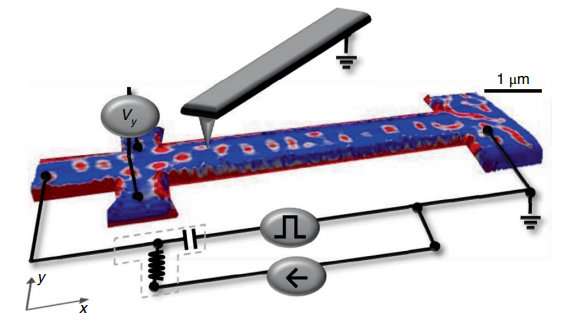February 14, 2018 report
A single magnetic skyrmion detected at room temperature for the first time

A team of researchers from CNRS, Thales and the Université Paris-Saclay, all in France has for the first time detected a single skyrmion at room temperature. In their paper published in the journal Nature Nanotechnology, the group describes their efforts, what they achieved and future avenues of research efforts.
Five years ago, a team at the University of Hamburg demonstrated for the first time that skyrmions could be used to store and erase data held on magnetic media. But to do that, the media had to be at a very cold temperature. In this new effort, the researchers in France have shown one of the important parts of memory storage—reading one unit—is possible at room temperature.
Skyrmions are a type of quasiparticle that exists on the surface of a magnetic material. They have been described as spinning magnetic swirls, and were first theorized more than 60 years ago by physicist Tony Skyrme—hence the name. Skyrmions can also move across a surface, like a mouse under a carpet, which has raised the possibility of using them in "racetrack memory" storage devices—they are particularly attractive because they are 10 times smaller than the spaces now used in modern electronic devices. But for practical applications, they need to be writable, readable and erasable at room temperature—this new research effort moves closer to achieving the second.
To ensure the accuracy of their results, the team used both concomitant electrical measurement and magnetic imaging using electrical pulses and detecting their presence by measuring their Hall resistivity. Part of the work was ensuring that a skyrmion created in a material could be isolated—to that end, they used electron-beam lithography to create a strip of skyrmions. That approach allowed for modifying the number of skyrmions created, their width and intensity, making the task of reading one less difficult.
The team notes that their achievement is just one small step on the path toward skyrmion-based memory devices, but suggest their work offers hope of an actual device being developed in 10 to 15 years.
More information: Davide Maccariello et al. Electrical detection of single magnetic skyrmions in metallic multilayers at room temperature, Nature Nanotechnology (2018). DOI: 10.1038/s41565-017-0044-4
Abstract
Magnetic skyrmions are topologically protected whirling spin textures that can be stabilized in magnetic materials by an asymmetric exchange interaction between neighbouring spins that imposes a fixed chirality. Their small size, together with the robustness against external perturbations, make magnetic skyrmions potential storage bits in a novel generation of memory and logic devices. To this aim, their contribution to the electrical transport properties of a device must be characterized—however, the existing demonstrations are limited to low temperatures and mainly in magnetic materials with a B20 crystal structure. Here we combine concomitant magnetic force microscopy and Hall resistivity measurements to demonstrate the electrical detection of sub-100 nm skyrmions in a multilayered thin film at room temperature. Furthermore, we detect and analyse the Hall signal of a single skyrmion, which indicates that it arises from the anomalous Hall effect with a negligible contribution from the topological Hall effect.
Journal information: Nature Nanotechnology
© 2018 Tech Xplore



















